Person-Centred Leadership: Relational Approach in Nursing Practice
VerifiedAdded on 2023/03/17
|31
|13443
|76
Report
AI Summary
This research article, authored by Shaun Cardiff and colleagues, presents a participatory action research study investigating person-centred leadership in clinical nursing. The study, conducted over three years in a Dutch hospital, explored how person-centred leadership manifests and develops. The research involved nurse leaders who planned, researched, and learned from their practice development, employing multiple data gathering methods, including critical and creative reflective inquiries, implementation of a new nursing system, and storytelling sessions. The findings reveal a set of attributes, relational processes, and contextual factors influencing person-centred leadership, supporting a conceptual framework. The study highlights person-centred leadership as a complex, dynamic, relational, and contextualized practice aimed at empowering associates and leaders for self-actualization, empowerment, and well-being. The research contributes to the wider clinical community by offering insights into nurse leadership as a relational and contextual phenomenon, demonstrating how clinical nurse leadership can be developed and researched in practice, and offering a reflective tool for leadership development.
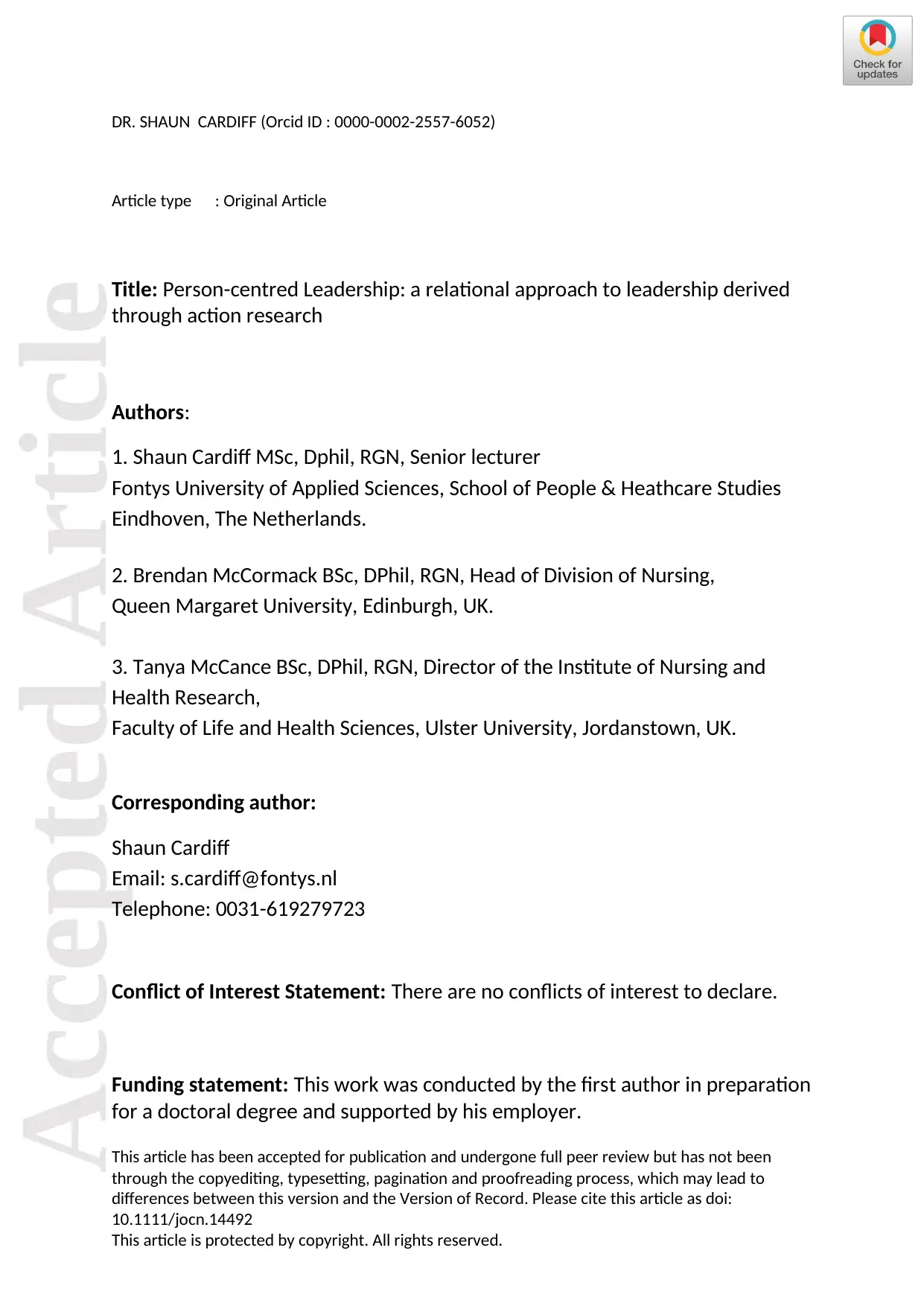
Accepted Article
This article has been accepted for publication and undergone full peer review but has not been
through the copyediting, typesetting, pagination and proofreading process, which may lead to
differences between this version and the Version of Record. Please cite this article as doi:
10.1111/jocn.14492
This article is protected by copyright. All rights reserved.
DR. SHAUN CARDIFF (Orcid ID : 0000-0002-2557-6052)
Article type : Original Article
Title: Person-centred Leadership: a relational approach to leadership derived
through action research
Authors:
1. Shaun Cardiff MSc, Dphil, RGN, Senior lecturer
Fontys University of Applied Sciences, School of People & Heathcare Studies
Eindhoven, The Netherlands.
2. Brendan McCormack BSc, DPhil, RGN, Head of Division of Nursing,
Queen Margaret University, Edinburgh, UK.
3. Tanya McCance BSc, DPhil, RGN, Director of the Institute of Nursing and
Health Research,
Faculty of Life and Health Sciences, Ulster University, Jordanstown, UK.
Corresponding author:
Shaun Cardiff
Email: s.cardiff@fontys.nl
Telephone: 0031-619279723
Conflict of Interest Statement: There are no conflicts of interest to declare.
Funding statement: This work was conducted by the first author in preparation
for a doctoral degree and supported by his employer.
This article has been accepted for publication and undergone full peer review but has not been
through the copyediting, typesetting, pagination and proofreading process, which may lead to
differences between this version and the Version of Record. Please cite this article as doi:
10.1111/jocn.14492
This article is protected by copyright. All rights reserved.
DR. SHAUN CARDIFF (Orcid ID : 0000-0002-2557-6052)
Article type : Original Article
Title: Person-centred Leadership: a relational approach to leadership derived
through action research
Authors:
1. Shaun Cardiff MSc, Dphil, RGN, Senior lecturer
Fontys University of Applied Sciences, School of People & Heathcare Studies
Eindhoven, The Netherlands.
2. Brendan McCormack BSc, DPhil, RGN, Head of Division of Nursing,
Queen Margaret University, Edinburgh, UK.
3. Tanya McCance BSc, DPhil, RGN, Director of the Institute of Nursing and
Health Research,
Faculty of Life and Health Sciences, Ulster University, Jordanstown, UK.
Corresponding author:
Shaun Cardiff
Email: s.cardiff@fontys.nl
Telephone: 0031-619279723
Conflict of Interest Statement: There are no conflicts of interest to declare.
Funding statement: This work was conducted by the first author in preparation
for a doctoral degree and supported by his employer.
Paraphrase This Document
Need a fresh take? Get an instant paraphrase of this document with our AI Paraphraser
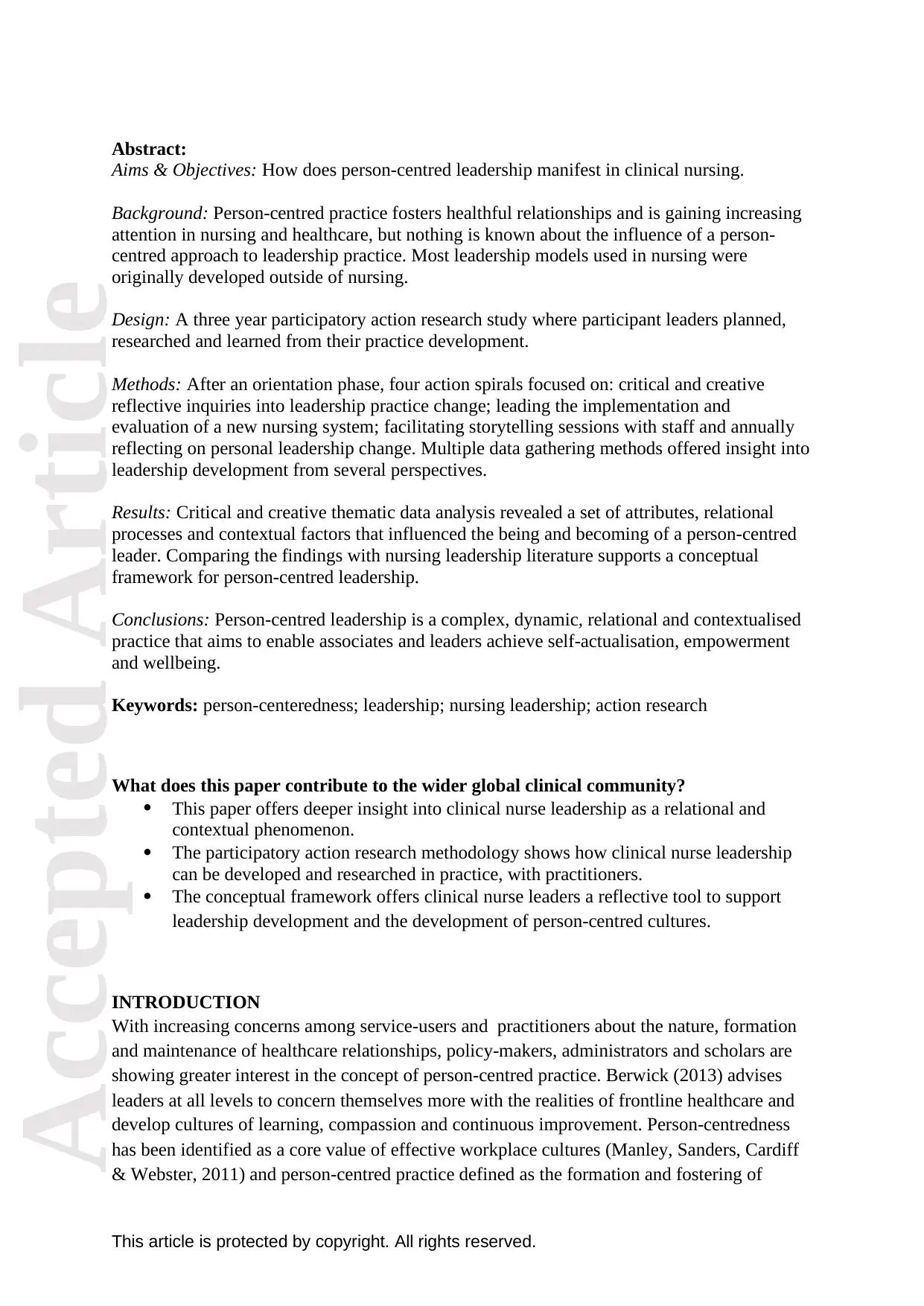
Accepted Article
This article is protected by copyright. All rights reserved.
Abstract:
Aims & Objectives: How does person-centred leadership manifest in clinical nursing.
Background: Person-centred practice fosters healthful relationships and is gaining increasing
attention in nursing and healthcare, but nothing is known about the influence of a person-
centred approach to leadership practice. Most leadership models used in nursing were
originally developed outside of nursing.
Design: A three year participatory action research study where participant leaders planned,
researched and learned from their practice development.
Methods: After an orientation phase, four action spirals focused on: critical and creative
reflective inquiries into leadership practice change; leading the implementation and
evaluation of a new nursing system; facilitating storytelling sessions with staff and annually
reflecting on personal leadership change. Multiple data gathering methods offered insight into
leadership development from several perspectives.
Results: Critical and creative thematic data analysis revealed a set of attributes, relational
processes and contextual factors that influenced the being and becoming of a person-centred
leader. Comparing the findings with nursing leadership literature supports a conceptual
framework for person-centred leadership.
Conclusions: Person-centred leadership is a complex, dynamic, relational and contextualised
practice that aims to enable associates and leaders achieve self-actualisation, empowerment
and wellbeing.
Keywords: person-centeredness; leadership; nursing leadership; action research
What does this paper contribute to the wider global clinical community?
This paper offers deeper insight into clinical nurse leadership as a relational and
contextual phenomenon.
The participatory action research methodology shows how clinical nurse leadership
can be developed and researched in practice, with practitioners.
The conceptual framework offers clinical nurse leaders a reflective tool to support
leadership development and the development of person-centred cultures.
INTRODUCTION
With increasing concerns among service-users and practitioners about the nature, formation
and maintenance of healthcare relationships, policy-makers, administrators and scholars are
showing greater interest in the concept of person-centred practice. Berwick (2013) advises
leaders at all levels to concern themselves more with the realities of frontline healthcare and
develop cultures of learning, compassion and continuous improvement. Person-centredness
has been identified as a core value of effective workplace cultures (Manley, Sanders, Cardiff
& Webster, 2011) and person-centred practice defined as the formation and fostering of
This article is protected by copyright. All rights reserved.
Abstract:
Aims & Objectives: How does person-centred leadership manifest in clinical nursing.
Background: Person-centred practice fosters healthful relationships and is gaining increasing
attention in nursing and healthcare, but nothing is known about the influence of a person-
centred approach to leadership practice. Most leadership models used in nursing were
originally developed outside of nursing.
Design: A three year participatory action research study where participant leaders planned,
researched and learned from their practice development.
Methods: After an orientation phase, four action spirals focused on: critical and creative
reflective inquiries into leadership practice change; leading the implementation and
evaluation of a new nursing system; facilitating storytelling sessions with staff and annually
reflecting on personal leadership change. Multiple data gathering methods offered insight into
leadership development from several perspectives.
Results: Critical and creative thematic data analysis revealed a set of attributes, relational
processes and contextual factors that influenced the being and becoming of a person-centred
leader. Comparing the findings with nursing leadership literature supports a conceptual
framework for person-centred leadership.
Conclusions: Person-centred leadership is a complex, dynamic, relational and contextualised
practice that aims to enable associates and leaders achieve self-actualisation, empowerment
and wellbeing.
Keywords: person-centeredness; leadership; nursing leadership; action research
What does this paper contribute to the wider global clinical community?
This paper offers deeper insight into clinical nurse leadership as a relational and
contextual phenomenon.
The participatory action research methodology shows how clinical nurse leadership
can be developed and researched in practice, with practitioners.
The conceptual framework offers clinical nurse leaders a reflective tool to support
leadership development and the development of person-centred cultures.
INTRODUCTION
With increasing concerns among service-users and practitioners about the nature, formation
and maintenance of healthcare relationships, policy-makers, administrators and scholars are
showing greater interest in the concept of person-centred practice. Berwick (2013) advises
leaders at all levels to concern themselves more with the realities of frontline healthcare and
develop cultures of learning, compassion and continuous improvement. Person-centredness
has been identified as a core value of effective workplace cultures (Manley, Sanders, Cardiff
& Webster, 2011) and person-centred practice defined as the formation and fostering of
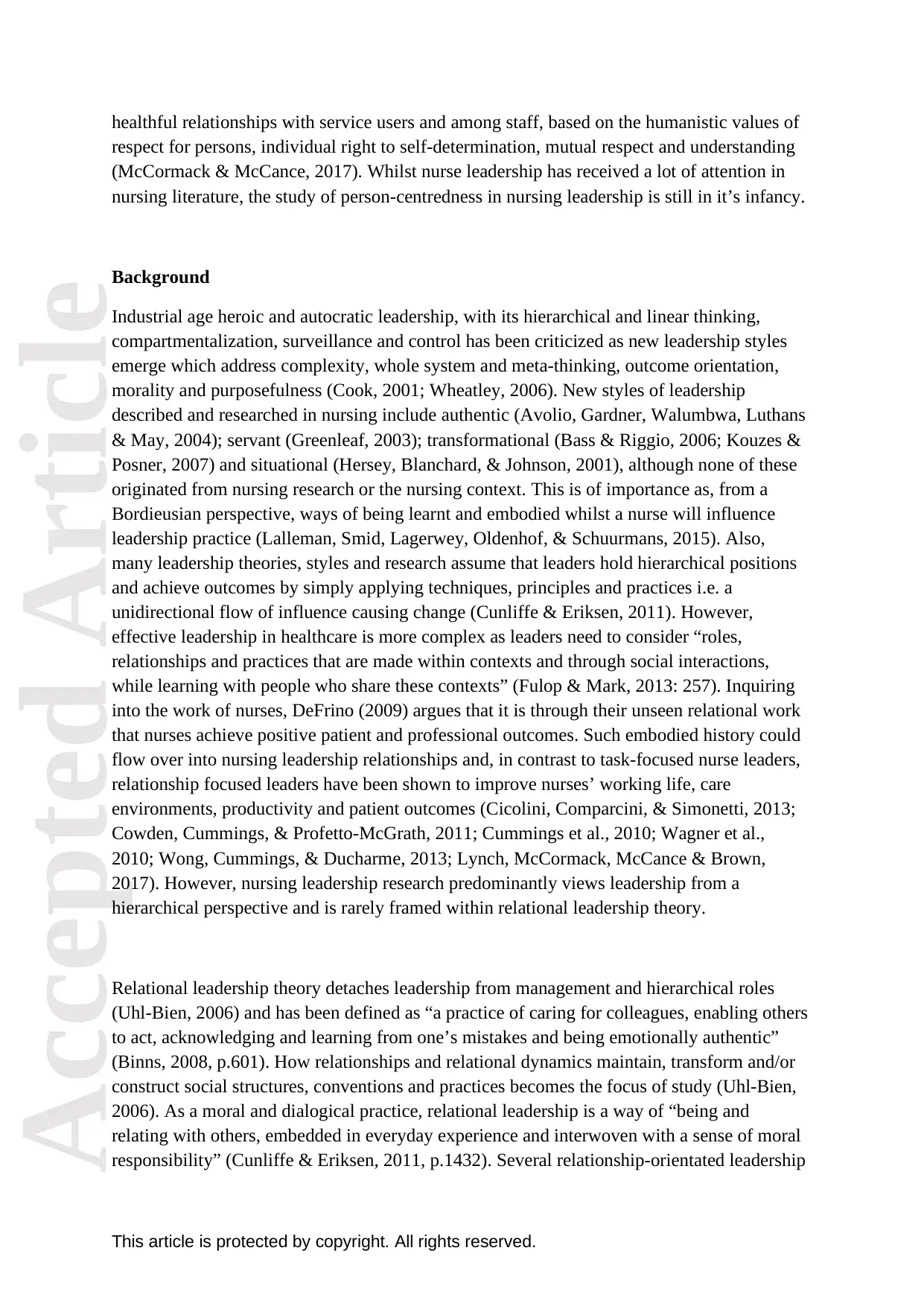
Accepted Article
This article is protected by copyright. All rights reserved.
healthful relationships with service users and among staff, based on the humanistic values of
respect for persons, individual right to self-determination, mutual respect and understanding
(McCormack & McCance, 2017). Whilst nurse leadership has received a lot of attention in
nursing literature, the study of person-centredness in nursing leadership is still in it’s infancy.
Background
Industrial age heroic and autocratic leadership, with its hierarchical and linear thinking,
compartmentalization, surveillance and control has been criticized as new leadership styles
emerge which address complexity, whole system and meta-thinking, outcome orientation,
morality and purposefulness (Cook, 2001; Wheatley, 2006). New styles of leadership
described and researched in nursing include authentic (Avolio, Gardner, Walumbwa, Luthans
& May, 2004); servant (Greenleaf, 2003); transformational (Bass & Riggio, 2006; Kouzes &
Posner, 2007) and situational (Hersey, Blanchard, & Johnson, 2001), although none of these
originated from nursing research or the nursing context. This is of importance as, from a
Bordieusian perspective, ways of being learnt and embodied whilst a nurse will influence
leadership practice (Lalleman, Smid, Lagerwey, Oldenhof, & Schuurmans, 2015). Also,
many leadership theories, styles and research assume that leaders hold hierarchical positions
and achieve outcomes by simply applying techniques, principles and practices i.e. a
unidirectional flow of influence causing change (Cunliffe & Eriksen, 2011). However,
effective leadership in healthcare is more complex as leaders need to consider “roles,
relationships and practices that are made within contexts and through social interactions,
while learning with people who share these contexts” (Fulop & Mark, 2013: 257). Inquiring
into the work of nurses, DeFrino (2009) argues that it is through their unseen relational work
that nurses achieve positive patient and professional outcomes. Such embodied history could
flow over into nursing leadership relationships and, in contrast to task-focused nurse leaders,
relationship focused leaders have been shown to improve nurses’ working life, care
environments, productivity and patient outcomes (Cicolini, Comparcini, & Simonetti, 2013;
Cowden, Cummings, & Profetto-McGrath, 2011; Cummings et al., 2010; Wagner et al.,
2010; Wong, Cummings, & Ducharme, 2013; Lynch, McCormack, McCance & Brown,
2017). However, nursing leadership research predominantly views leadership from a
hierarchical perspective and is rarely framed within relational leadership theory.
Relational leadership theory detaches leadership from management and hierarchical roles
(Uhl-Bien, 2006) and has been defined as “a practice of caring for colleagues, enabling others
to act, acknowledging and learning from one’s mistakes and being emotionally authentic”
(Binns, 2008, p.601). How relationships and relational dynamics maintain, transform and/or
construct social structures, conventions and practices becomes the focus of study (Uhl-Bien,
2006). As a moral and dialogical practice, relational leadership is a way of “being and
relating with others, embedded in everyday experience and interwoven with a sense of moral
responsibility” (Cunliffe & Eriksen, 2011, p.1432). Several relationship-orientated leadership
This article is protected by copyright. All rights reserved.
healthful relationships with service users and among staff, based on the humanistic values of
respect for persons, individual right to self-determination, mutual respect and understanding
(McCormack & McCance, 2017). Whilst nurse leadership has received a lot of attention in
nursing literature, the study of person-centredness in nursing leadership is still in it’s infancy.
Background
Industrial age heroic and autocratic leadership, with its hierarchical and linear thinking,
compartmentalization, surveillance and control has been criticized as new leadership styles
emerge which address complexity, whole system and meta-thinking, outcome orientation,
morality and purposefulness (Cook, 2001; Wheatley, 2006). New styles of leadership
described and researched in nursing include authentic (Avolio, Gardner, Walumbwa, Luthans
& May, 2004); servant (Greenleaf, 2003); transformational (Bass & Riggio, 2006; Kouzes &
Posner, 2007) and situational (Hersey, Blanchard, & Johnson, 2001), although none of these
originated from nursing research or the nursing context. This is of importance as, from a
Bordieusian perspective, ways of being learnt and embodied whilst a nurse will influence
leadership practice (Lalleman, Smid, Lagerwey, Oldenhof, & Schuurmans, 2015). Also,
many leadership theories, styles and research assume that leaders hold hierarchical positions
and achieve outcomes by simply applying techniques, principles and practices i.e. a
unidirectional flow of influence causing change (Cunliffe & Eriksen, 2011). However,
effective leadership in healthcare is more complex as leaders need to consider “roles,
relationships and practices that are made within contexts and through social interactions,
while learning with people who share these contexts” (Fulop & Mark, 2013: 257). Inquiring
into the work of nurses, DeFrino (2009) argues that it is through their unseen relational work
that nurses achieve positive patient and professional outcomes. Such embodied history could
flow over into nursing leadership relationships and, in contrast to task-focused nurse leaders,
relationship focused leaders have been shown to improve nurses’ working life, care
environments, productivity and patient outcomes (Cicolini, Comparcini, & Simonetti, 2013;
Cowden, Cummings, & Profetto-McGrath, 2011; Cummings et al., 2010; Wagner et al.,
2010; Wong, Cummings, & Ducharme, 2013; Lynch, McCormack, McCance & Brown,
2017). However, nursing leadership research predominantly views leadership from a
hierarchical perspective and is rarely framed within relational leadership theory.
Relational leadership theory detaches leadership from management and hierarchical roles
(Uhl-Bien, 2006) and has been defined as “a practice of caring for colleagues, enabling others
to act, acknowledging and learning from one’s mistakes and being emotionally authentic”
(Binns, 2008, p.601). How relationships and relational dynamics maintain, transform and/or
construct social structures, conventions and practices becomes the focus of study (Uhl-Bien,
2006). As a moral and dialogical practice, relational leadership is a way of “being and
relating with others, embedded in everyday experience and interwoven with a sense of moral
responsibility” (Cunliffe & Eriksen, 2011, p.1432). Several relationship-orientated leadership
⊘ This is a preview!⊘
Do you want full access?
Subscribe today to unlock all pages.

Trusted by 1+ million students worldwide
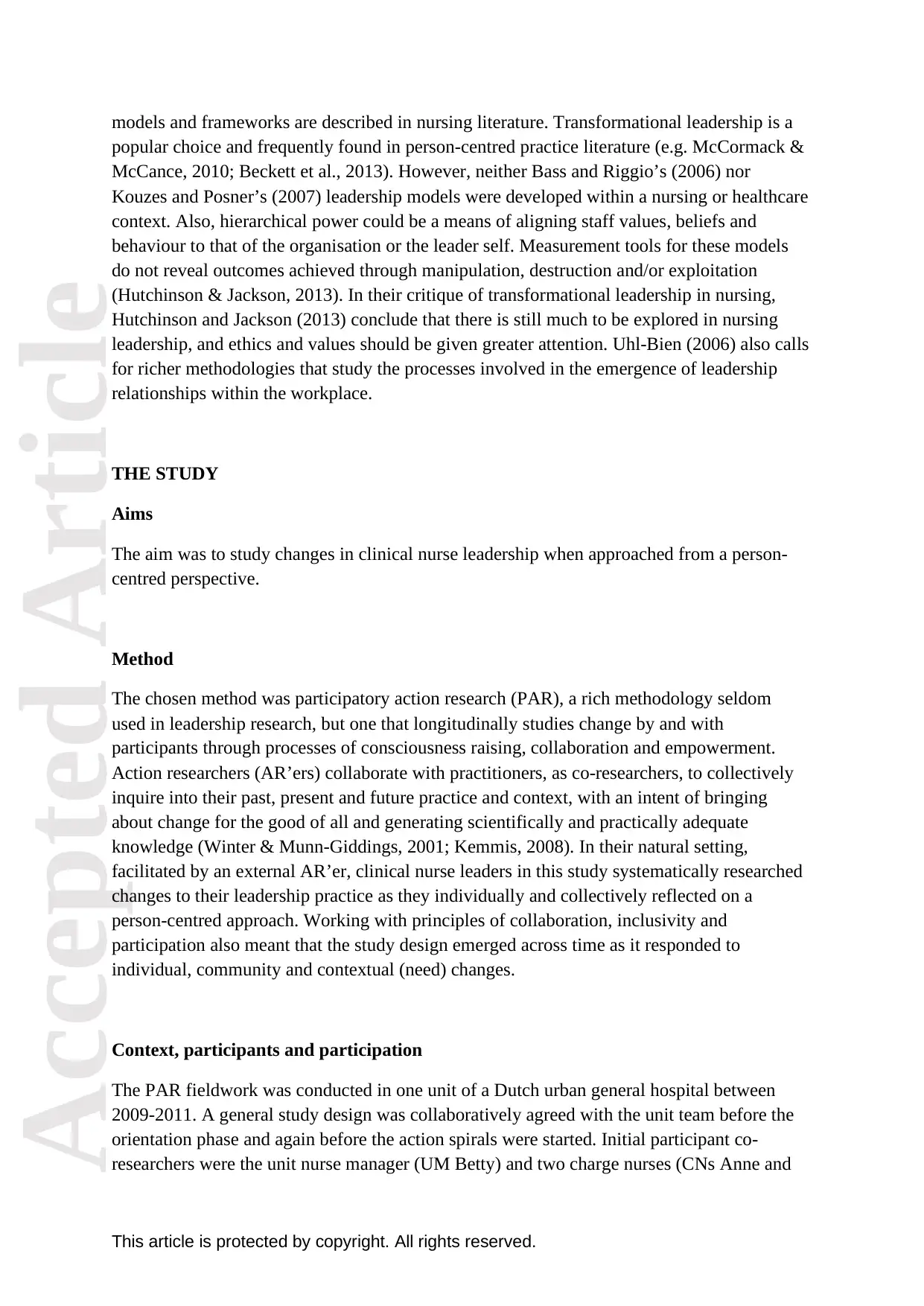
Accepted Article
This article is protected by copyright. All rights reserved.
models and frameworks are described in nursing literature. Transformational leadership is a
popular choice and frequently found in person-centred practice literature (e.g. McCormack &
McCance, 2010; Beckett et al., 2013). However, neither Bass and Riggio’s (2006) nor
Kouzes and Posner’s (2007) leadership models were developed within a nursing or healthcare
context. Also, hierarchical power could be a means of aligning staff values, beliefs and
behaviour to that of the organisation or the leader self. Measurement tools for these models
do not reveal outcomes achieved through manipulation, destruction and/or exploitation
(Hutchinson & Jackson, 2013). In their critique of transformational leadership in nursing,
Hutchinson and Jackson (2013) conclude that there is still much to be explored in nursing
leadership, and ethics and values should be given greater attention. Uhl-Bien (2006) also calls
for richer methodologies that study the processes involved in the emergence of leadership
relationships within the workplace.
THE STUDY
Aims
The aim was to study changes in clinical nurse leadership when approached from a person-
centred perspective.
Method
The chosen method was participatory action research (PAR), a rich methodology seldom
used in leadership research, but one that longitudinally studies change by and with
participants through processes of consciousness raising, collaboration and empowerment.
Action researchers (AR’ers) collaborate with practitioners, as co-researchers, to collectively
inquire into their past, present and future practice and context, with an intent of bringing
about change for the good of all and generating scientifically and practically adequate
knowledge (Winter & Munn-Giddings, 2001; Kemmis, 2008). In their natural setting,
facilitated by an external AR’er, clinical nurse leaders in this study systematically researched
changes to their leadership practice as they individually and collectively reflected on a
person-centred approach. Working with principles of collaboration, inclusivity and
participation also meant that the study design emerged across time as it responded to
individual, community and contextual (need) changes.
Context, participants and participation
The PAR fieldwork was conducted in one unit of a Dutch urban general hospital between
2009-2011. A general study design was collaboratively agreed with the unit team before the
orientation phase and again before the action spirals were started. Initial participant co-
researchers were the unit nurse manager (UM Betty) and two charge nurses (CNs Anne and
This article is protected by copyright. All rights reserved.
models and frameworks are described in nursing literature. Transformational leadership is a
popular choice and frequently found in person-centred practice literature (e.g. McCormack &
McCance, 2010; Beckett et al., 2013). However, neither Bass and Riggio’s (2006) nor
Kouzes and Posner’s (2007) leadership models were developed within a nursing or healthcare
context. Also, hierarchical power could be a means of aligning staff values, beliefs and
behaviour to that of the organisation or the leader self. Measurement tools for these models
do not reveal outcomes achieved through manipulation, destruction and/or exploitation
(Hutchinson & Jackson, 2013). In their critique of transformational leadership in nursing,
Hutchinson and Jackson (2013) conclude that there is still much to be explored in nursing
leadership, and ethics and values should be given greater attention. Uhl-Bien (2006) also calls
for richer methodologies that study the processes involved in the emergence of leadership
relationships within the workplace.
THE STUDY
Aims
The aim was to study changes in clinical nurse leadership when approached from a person-
centred perspective.
Method
The chosen method was participatory action research (PAR), a rich methodology seldom
used in leadership research, but one that longitudinally studies change by and with
participants through processes of consciousness raising, collaboration and empowerment.
Action researchers (AR’ers) collaborate with practitioners, as co-researchers, to collectively
inquire into their past, present and future practice and context, with an intent of bringing
about change for the good of all and generating scientifically and practically adequate
knowledge (Winter & Munn-Giddings, 2001; Kemmis, 2008). In their natural setting,
facilitated by an external AR’er, clinical nurse leaders in this study systematically researched
changes to their leadership practice as they individually and collectively reflected on a
person-centred approach. Working with principles of collaboration, inclusivity and
participation also meant that the study design emerged across time as it responded to
individual, community and contextual (need) changes.
Context, participants and participation
The PAR fieldwork was conducted in one unit of a Dutch urban general hospital between
2009-2011. A general study design was collaboratively agreed with the unit team before the
orientation phase and again before the action spirals were started. Initial participant co-
researchers were the unit nurse manager (UM Betty) and two charge nurses (CNs Anne and
Paraphrase This Document
Need a fresh take? Get an instant paraphrase of this document with our AI Paraphraser
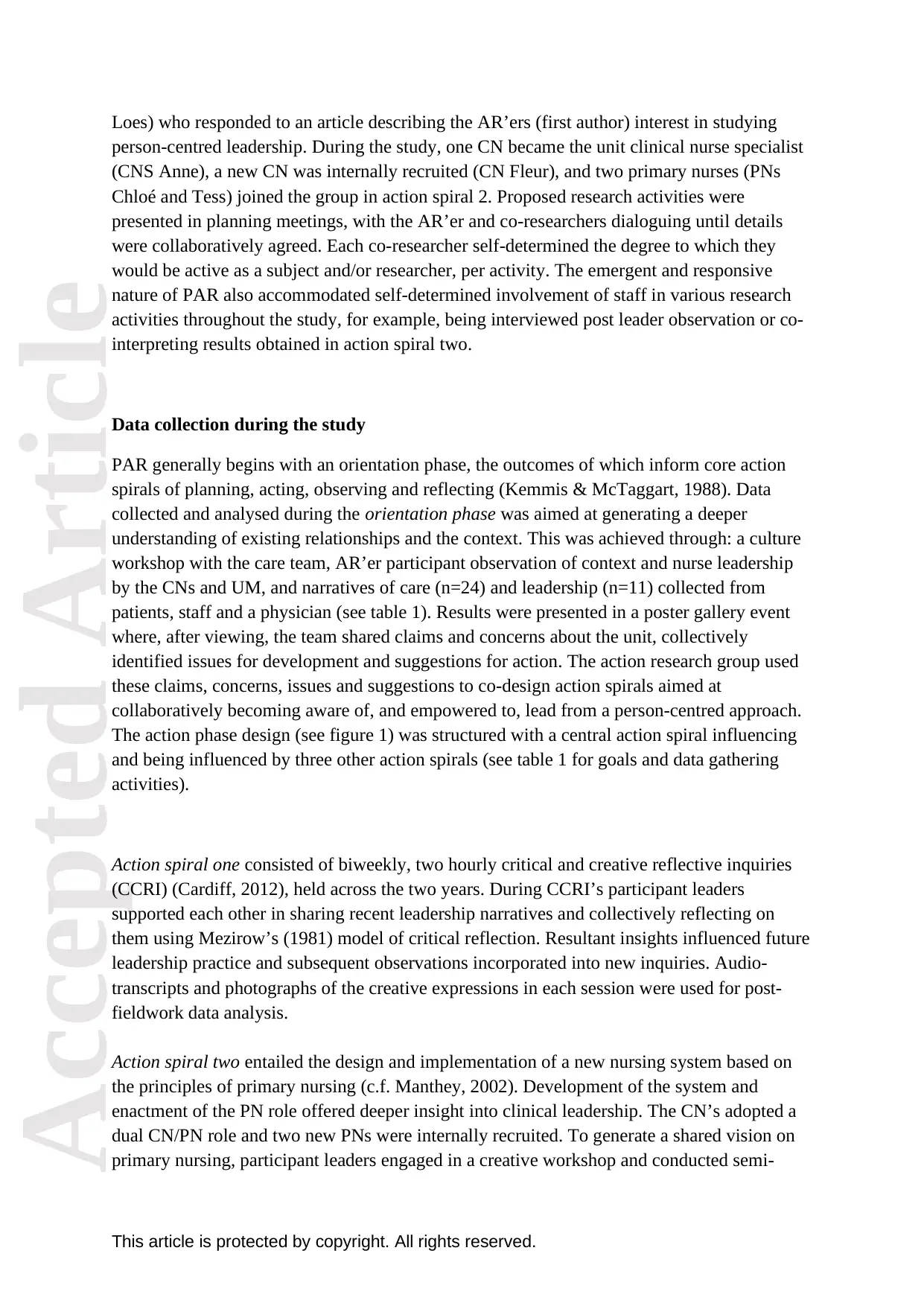
Accepted Article
This article is protected by copyright. All rights reserved.
Loes) who responded to an article describing the AR’ers (first author) interest in studying
person-centred leadership. During the study, one CN became the unit clinical nurse specialist
(CNS Anne), a new CN was internally recruited (CN Fleur), and two primary nurses (PNs
Chloé and Tess) joined the group in action spiral 2. Proposed research activities were
presented in planning meetings, with the AR’er and co-researchers dialoguing until details
were collaboratively agreed. Each co-researcher self-determined the degree to which they
would be active as a subject and/or researcher, per activity. The emergent and responsive
nature of PAR also accommodated self-determined involvement of staff in various research
activities throughout the study, for example, being interviewed post leader observation or co-
interpreting results obtained in action spiral two.
Data collection during the study
PAR generally begins with an orientation phase, the outcomes of which inform core action
spirals of planning, acting, observing and reflecting (Kemmis & McTaggart, 1988). Data
collected and analysed during the orientation phase was aimed at generating a deeper
understanding of existing relationships and the context. This was achieved through: a culture
workshop with the care team, AR’er participant observation of context and nurse leadership
by the CNs and UM, and narratives of care (n=24) and leadership (n=11) collected from
patients, staff and a physician (see table 1). Results were presented in a poster gallery event
where, after viewing, the team shared claims and concerns about the unit, collectively
identified issues for development and suggestions for action. The action research group used
these claims, concerns, issues and suggestions to co-design action spirals aimed at
collaboratively becoming aware of, and empowered to, lead from a person-centred approach.
The action phase design (see figure 1) was structured with a central action spiral influencing
and being influenced by three other action spirals (see table 1 for goals and data gathering
activities).
Action spiral one consisted of biweekly, two hourly critical and creative reflective inquiries
(CCRI) (Cardiff, 2012), held across the two years. During CCRI’s participant leaders
supported each other in sharing recent leadership narratives and collectively reflecting on
them using Mezirow’s (1981) model of critical reflection. Resultant insights influenced future
leadership practice and subsequent observations incorporated into new inquiries. Audio-
transcripts and photographs of the creative expressions in each session were used for post-
fieldwork data analysis.
Action spiral two entailed the design and implementation of a new nursing system based on
the principles of primary nursing (c.f. Manthey, 2002). Development of the system and
enactment of the PN role offered deeper insight into clinical leadership. The CN’s adopted a
dual CN/PN role and two new PNs were internally recruited. To generate a shared vision on
primary nursing, participant leaders engaged in a creative workshop and conducted semi-
This article is protected by copyright. All rights reserved.
Loes) who responded to an article describing the AR’ers (first author) interest in studying
person-centred leadership. During the study, one CN became the unit clinical nurse specialist
(CNS Anne), a new CN was internally recruited (CN Fleur), and two primary nurses (PNs
Chloé and Tess) joined the group in action spiral 2. Proposed research activities were
presented in planning meetings, with the AR’er and co-researchers dialoguing until details
were collaboratively agreed. Each co-researcher self-determined the degree to which they
would be active as a subject and/or researcher, per activity. The emergent and responsive
nature of PAR also accommodated self-determined involvement of staff in various research
activities throughout the study, for example, being interviewed post leader observation or co-
interpreting results obtained in action spiral two.
Data collection during the study
PAR generally begins with an orientation phase, the outcomes of which inform core action
spirals of planning, acting, observing and reflecting (Kemmis & McTaggart, 1988). Data
collected and analysed during the orientation phase was aimed at generating a deeper
understanding of existing relationships and the context. This was achieved through: a culture
workshop with the care team, AR’er participant observation of context and nurse leadership
by the CNs and UM, and narratives of care (n=24) and leadership (n=11) collected from
patients, staff and a physician (see table 1). Results were presented in a poster gallery event
where, after viewing, the team shared claims and concerns about the unit, collectively
identified issues for development and suggestions for action. The action research group used
these claims, concerns, issues and suggestions to co-design action spirals aimed at
collaboratively becoming aware of, and empowered to, lead from a person-centred approach.
The action phase design (see figure 1) was structured with a central action spiral influencing
and being influenced by three other action spirals (see table 1 for goals and data gathering
activities).
Action spiral one consisted of biweekly, two hourly critical and creative reflective inquiries
(CCRI) (Cardiff, 2012), held across the two years. During CCRI’s participant leaders
supported each other in sharing recent leadership narratives and collectively reflecting on
them using Mezirow’s (1981) model of critical reflection. Resultant insights influenced future
leadership practice and subsequent observations incorporated into new inquiries. Audio-
transcripts and photographs of the creative expressions in each session were used for post-
fieldwork data analysis.
Action spiral two entailed the design and implementation of a new nursing system based on
the principles of primary nursing (c.f. Manthey, 2002). Development of the system and
enactment of the PN role offered deeper insight into clinical leadership. The CN’s adopted a
dual CN/PN role and two new PNs were internally recruited. To generate a shared vision on
primary nursing, participant leaders engaged in a creative workshop and conducted semi-
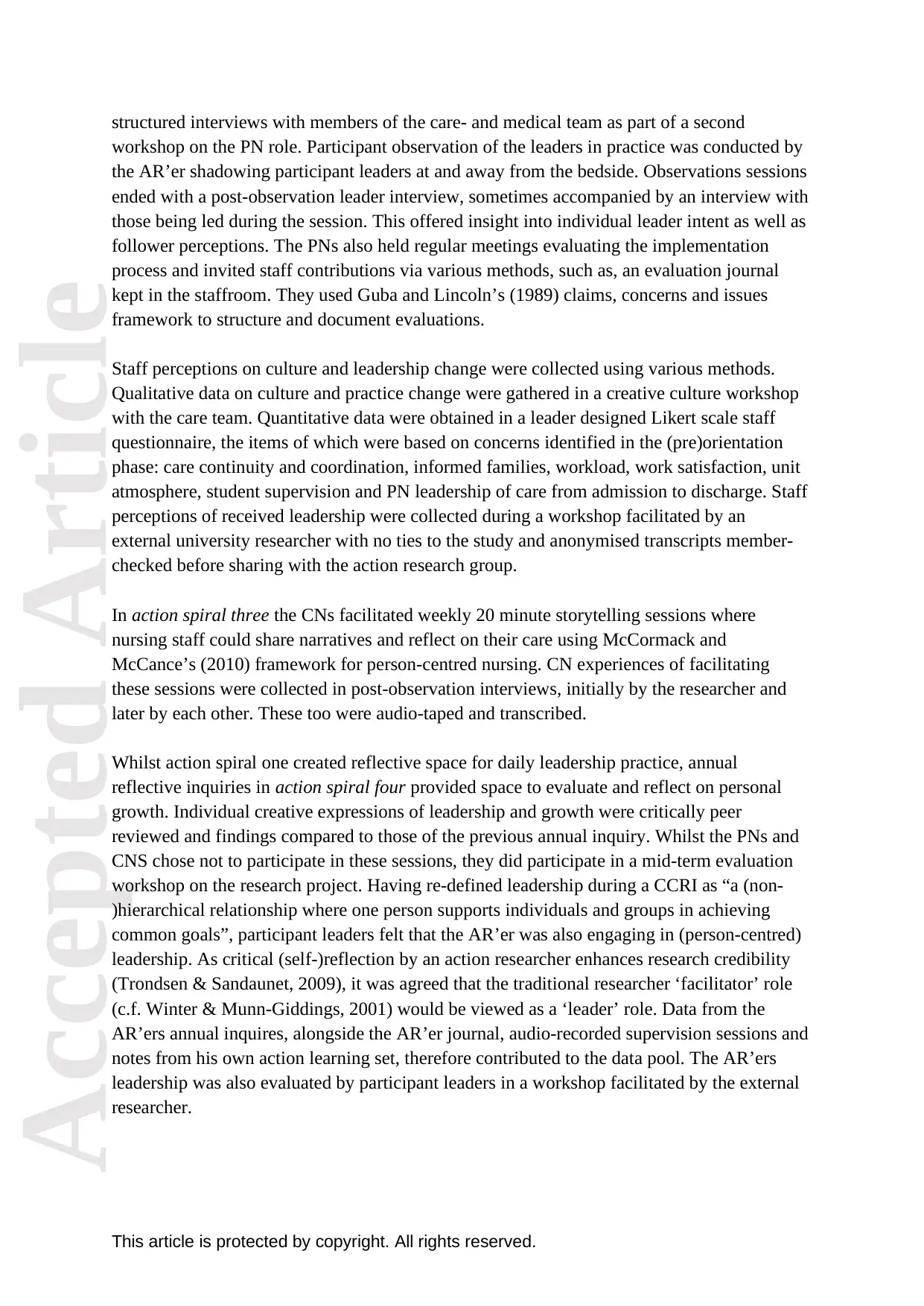
Accepted Article
This article is protected by copyright. All rights reserved.
structured interviews with members of the care- and medical team as part of a second
workshop on the PN role. Participant observation of the leaders in practice was conducted by
the AR’er shadowing participant leaders at and away from the bedside. Observations sessions
ended with a post-observation leader interview, sometimes accompanied by an interview with
those being led during the session. This offered insight into individual leader intent as well as
follower perceptions. The PNs also held regular meetings evaluating the implementation
process and invited staff contributions via various methods, such as, an evaluation journal
kept in the staffroom. They used Guba and Lincoln’s (1989) claims, concerns and issues
framework to structure and document evaluations.
Staff perceptions on culture and leadership change were collected using various methods.
Qualitative data on culture and practice change were gathered in a creative culture workshop
with the care team. Quantitative data were obtained in a leader designed Likert scale staff
questionnaire, the items of which were based on concerns identified in the (pre)orientation
phase: care continuity and coordination, informed families, workload, work satisfaction, unit
atmosphere, student supervision and PN leadership of care from admission to discharge. Staff
perceptions of received leadership were collected during a workshop facilitated by an
external university researcher with no ties to the study and anonymised transcripts member-
checked before sharing with the action research group.
In action spiral three the CNs facilitated weekly 20 minute storytelling sessions where
nursing staff could share narratives and reflect on their care using McCormack and
McCance’s (2010) framework for person-centred nursing. CN experiences of facilitating
these sessions were collected in post-observation interviews, initially by the researcher and
later by each other. These too were audio-taped and transcribed.
Whilst action spiral one created reflective space for daily leadership practice, annual
reflective inquiries in action spiral four provided space to evaluate and reflect on personal
growth. Individual creative expressions of leadership and growth were critically peer
reviewed and findings compared to those of the previous annual inquiry. Whilst the PNs and
CNS chose not to participate in these sessions, they did participate in a mid-term evaluation
workshop on the research project. Having re-defined leadership during a CCRI as “a (non-
)hierarchical relationship where one person supports individuals and groups in achieving
common goals”, participant leaders felt that the AR’er was also engaging in (person-centred)
leadership. As critical (self-)reflection by an action researcher enhances research credibility
(Trondsen & Sandaunet, 2009), it was agreed that the traditional researcher ‘facilitator’ role
(c.f. Winter & Munn-Giddings, 2001) would be viewed as a ‘leader’ role. Data from the
AR’ers annual inquires, alongside the AR’er journal, audio-recorded supervision sessions and
notes from his own action learning set, therefore contributed to the data pool. The AR’ers
leadership was also evaluated by participant leaders in a workshop facilitated by the external
researcher.
This article is protected by copyright. All rights reserved.
structured interviews with members of the care- and medical team as part of a second
workshop on the PN role. Participant observation of the leaders in practice was conducted by
the AR’er shadowing participant leaders at and away from the bedside. Observations sessions
ended with a post-observation leader interview, sometimes accompanied by an interview with
those being led during the session. This offered insight into individual leader intent as well as
follower perceptions. The PNs also held regular meetings evaluating the implementation
process and invited staff contributions via various methods, such as, an evaluation journal
kept in the staffroom. They used Guba and Lincoln’s (1989) claims, concerns and issues
framework to structure and document evaluations.
Staff perceptions on culture and leadership change were collected using various methods.
Qualitative data on culture and practice change were gathered in a creative culture workshop
with the care team. Quantitative data were obtained in a leader designed Likert scale staff
questionnaire, the items of which were based on concerns identified in the (pre)orientation
phase: care continuity and coordination, informed families, workload, work satisfaction, unit
atmosphere, student supervision and PN leadership of care from admission to discharge. Staff
perceptions of received leadership were collected during a workshop facilitated by an
external university researcher with no ties to the study and anonymised transcripts member-
checked before sharing with the action research group.
In action spiral three the CNs facilitated weekly 20 minute storytelling sessions where
nursing staff could share narratives and reflect on their care using McCormack and
McCance’s (2010) framework for person-centred nursing. CN experiences of facilitating
these sessions were collected in post-observation interviews, initially by the researcher and
later by each other. These too were audio-taped and transcribed.
Whilst action spiral one created reflective space for daily leadership practice, annual
reflective inquiries in action spiral four provided space to evaluate and reflect on personal
growth. Individual creative expressions of leadership and growth were critically peer
reviewed and findings compared to those of the previous annual inquiry. Whilst the PNs and
CNS chose not to participate in these sessions, they did participate in a mid-term evaluation
workshop on the research project. Having re-defined leadership during a CCRI as “a (non-
)hierarchical relationship where one person supports individuals and groups in achieving
common goals”, participant leaders felt that the AR’er was also engaging in (person-centred)
leadership. As critical (self-)reflection by an action researcher enhances research credibility
(Trondsen & Sandaunet, 2009), it was agreed that the traditional researcher ‘facilitator’ role
(c.f. Winter & Munn-Giddings, 2001) would be viewed as a ‘leader’ role. Data from the
AR’ers annual inquires, alongside the AR’er journal, audio-recorded supervision sessions and
notes from his own action learning set, therefore contributed to the data pool. The AR’ers
leadership was also evaluated by participant leaders in a workshop facilitated by the external
researcher.
⊘ This is a preview!⊘
Do you want full access?
Subscribe today to unlock all pages.

Trusted by 1+ million students worldwide
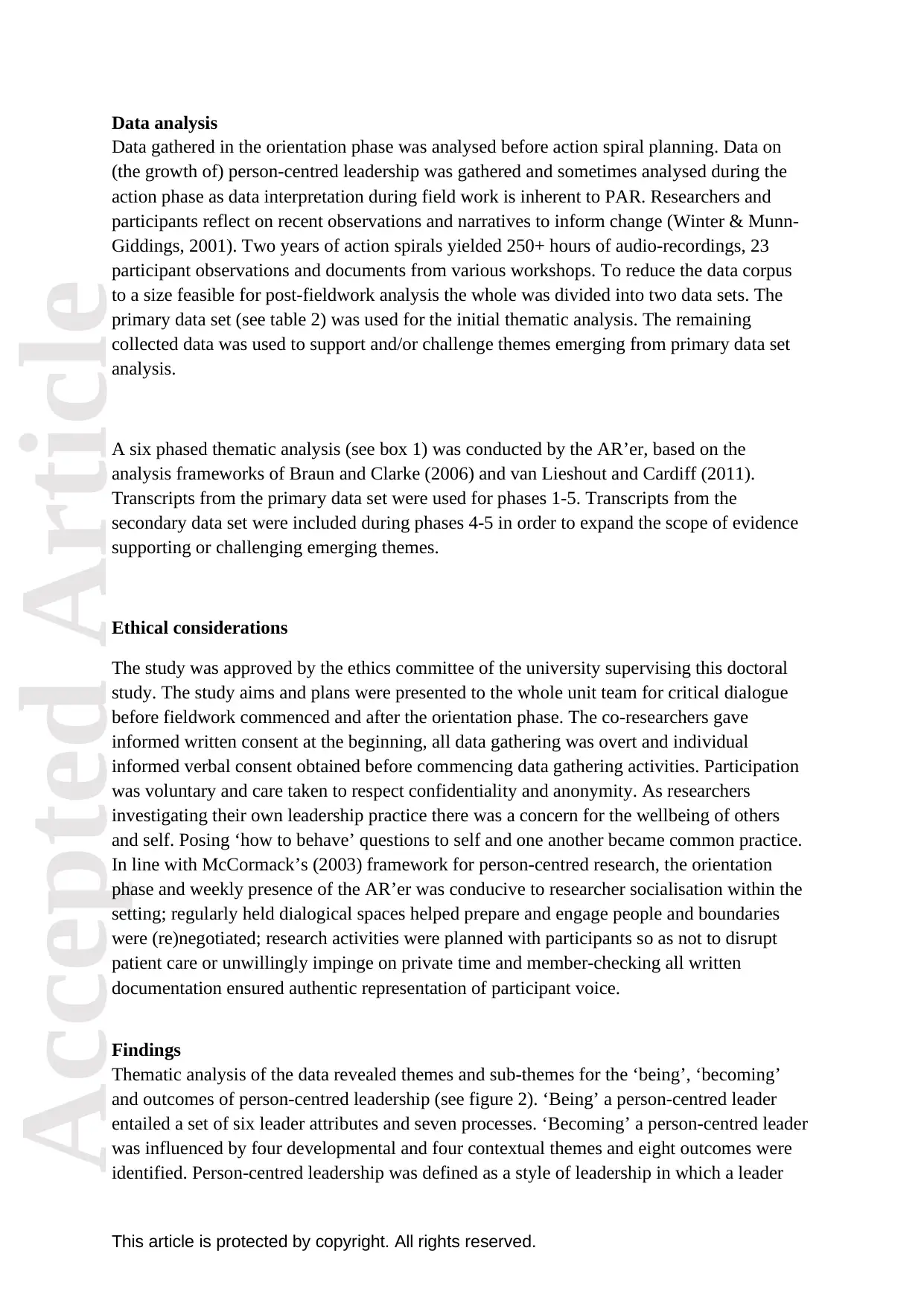
Accepted Article
This article is protected by copyright. All rights reserved.
Data analysis
Data gathered in the orientation phase was analysed before action spiral planning. Data on
(the growth of) person-centred leadership was gathered and sometimes analysed during the
action phase as data interpretation during field work is inherent to PAR. Researchers and
participants reflect on recent observations and narratives to inform change (Winter & Munn-
Giddings, 2001). Two years of action spirals yielded 250+ hours of audio-recordings, 23
participant observations and documents from various workshops. To reduce the data corpus
to a size feasible for post-fieldwork analysis the whole was divided into two data sets. The
primary data set (see table 2) was used for the initial thematic analysis. The remaining
collected data was used to support and/or challenge themes emerging from primary data set
analysis.
A six phased thematic analysis (see box 1) was conducted by the AR’er, based on the
analysis frameworks of Braun and Clarke (2006) and van Lieshout and Cardiff (2011).
Transcripts from the primary data set were used for phases 1-5. Transcripts from the
secondary data set were included during phases 4-5 in order to expand the scope of evidence
supporting or challenging emerging themes.
Ethical considerations
The study was approved by the ethics committee of the university supervising this doctoral
study. The study aims and plans were presented to the whole unit team for critical dialogue
before fieldwork commenced and after the orientation phase. The co-researchers gave
informed written consent at the beginning, all data gathering was overt and individual
informed verbal consent obtained before commencing data gathering activities. Participation
was voluntary and care taken to respect confidentiality and anonymity. As researchers
investigating their own leadership practice there was a concern for the wellbeing of others
and self. Posing ‘how to behave’ questions to self and one another became common practice.
In line with McCormack’s (2003) framework for person-centred research, the orientation
phase and weekly presence of the AR’er was conducive to researcher socialisation within the
setting; regularly held dialogical spaces helped prepare and engage people and boundaries
were (re)negotiated; research activities were planned with participants so as not to disrupt
patient care or unwillingly impinge on private time and member-checking all written
documentation ensured authentic representation of participant voice.
Findings
Thematic analysis of the data revealed themes and sub-themes for the ‘being’, ‘becoming’
and outcomes of person-centred leadership (see figure 2). ‘Being’ a person-centred leader
entailed a set of six leader attributes and seven processes. ‘Becoming’ a person-centred leader
was influenced by four developmental and four contextual themes and eight outcomes were
identified. Person-centred leadership was defined as a style of leadership in which a leader
This article is protected by copyright. All rights reserved.
Data analysis
Data gathered in the orientation phase was analysed before action spiral planning. Data on
(the growth of) person-centred leadership was gathered and sometimes analysed during the
action phase as data interpretation during field work is inherent to PAR. Researchers and
participants reflect on recent observations and narratives to inform change (Winter & Munn-
Giddings, 2001). Two years of action spirals yielded 250+ hours of audio-recordings, 23
participant observations and documents from various workshops. To reduce the data corpus
to a size feasible for post-fieldwork analysis the whole was divided into two data sets. The
primary data set (see table 2) was used for the initial thematic analysis. The remaining
collected data was used to support and/or challenge themes emerging from primary data set
analysis.
A six phased thematic analysis (see box 1) was conducted by the AR’er, based on the
analysis frameworks of Braun and Clarke (2006) and van Lieshout and Cardiff (2011).
Transcripts from the primary data set were used for phases 1-5. Transcripts from the
secondary data set were included during phases 4-5 in order to expand the scope of evidence
supporting or challenging emerging themes.
Ethical considerations
The study was approved by the ethics committee of the university supervising this doctoral
study. The study aims and plans were presented to the whole unit team for critical dialogue
before fieldwork commenced and after the orientation phase. The co-researchers gave
informed written consent at the beginning, all data gathering was overt and individual
informed verbal consent obtained before commencing data gathering activities. Participation
was voluntary and care taken to respect confidentiality and anonymity. As researchers
investigating their own leadership practice there was a concern for the wellbeing of others
and self. Posing ‘how to behave’ questions to self and one another became common practice.
In line with McCormack’s (2003) framework for person-centred research, the orientation
phase and weekly presence of the AR’er was conducive to researcher socialisation within the
setting; regularly held dialogical spaces helped prepare and engage people and boundaries
were (re)negotiated; research activities were planned with participants so as not to disrupt
patient care or unwillingly impinge on private time and member-checking all written
documentation ensured authentic representation of participant voice.
Findings
Thematic analysis of the data revealed themes and sub-themes for the ‘being’, ‘becoming’
and outcomes of person-centred leadership (see figure 2). ‘Being’ a person-centred leader
entailed a set of six leader attributes and seven processes. ‘Becoming’ a person-centred leader
was influenced by four developmental and four contextual themes and eight outcomes were
identified. Person-centred leadership was defined as a style of leadership in which a leader
Paraphrase This Document
Need a fresh take? Get an instant paraphrase of this document with our AI Paraphraser
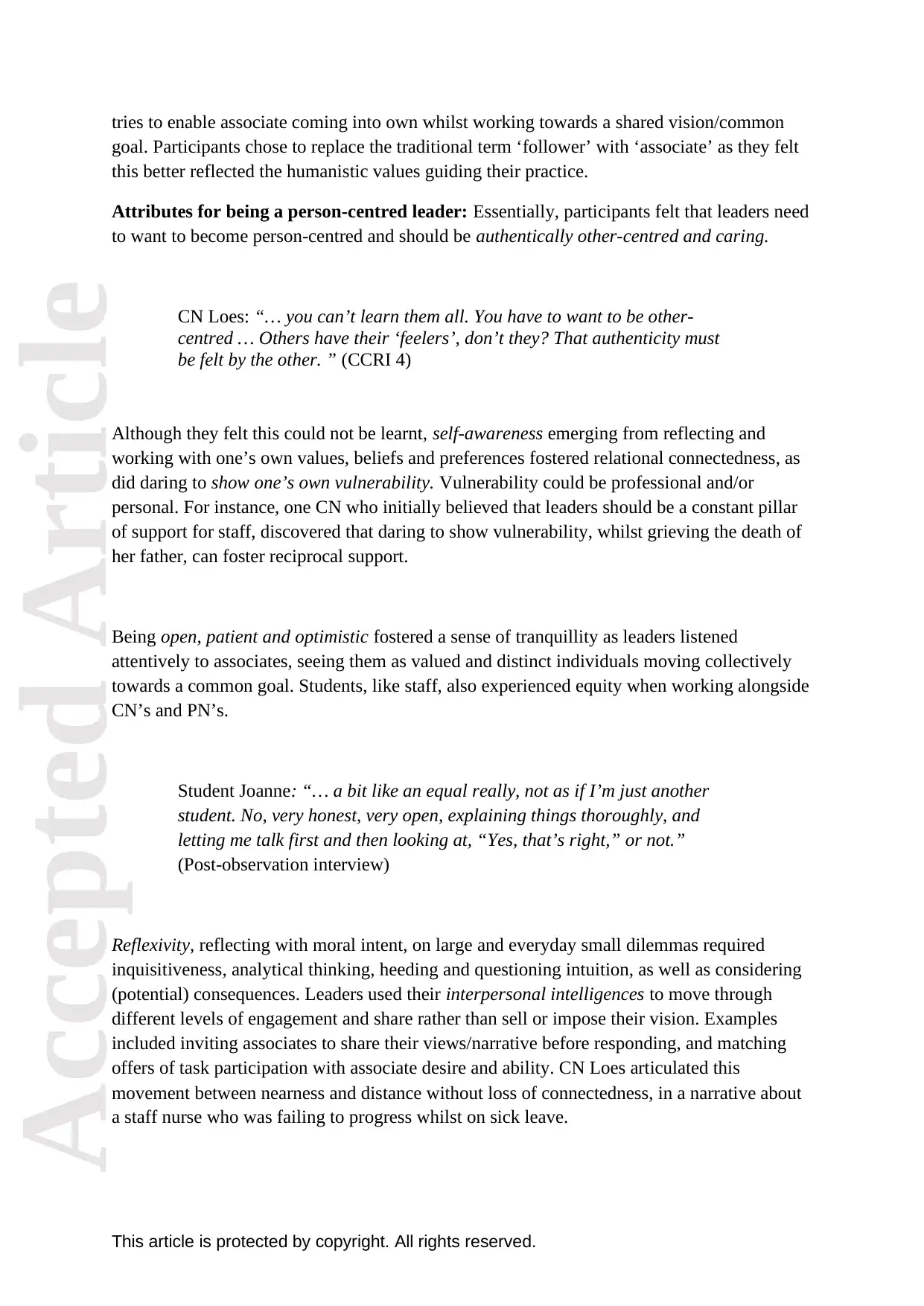
Accepted Article
This article is protected by copyright. All rights reserved.
tries to enable associate coming into own whilst working towards a shared vision/common
goal. Participants chose to replace the traditional term ‘follower’ with ‘associate’ as they felt
this better reflected the humanistic values guiding their practice.
Attributes for being a person-centred leader: Essentially, participants felt that leaders need
to want to become person-centred and should be authentically other-centred and caring.
CN Loes: “… you can’t learn them all. You have to want to be other-
centred … Others have their ‘feelers’, don’t they? That authenticity must
be felt by the other. ” (CCRI 4)
Although they felt this could not be learnt, self-awareness emerging from reflecting and
working with one’s own values, beliefs and preferences fostered relational connectedness, as
did daring to show one’s own vulnerability. Vulnerability could be professional and/or
personal. For instance, one CN who initially believed that leaders should be a constant pillar
of support for staff, discovered that daring to show vulnerability, whilst grieving the death of
her father, can foster reciprocal support.
Being open, patient and optimistic fostered a sense of tranquillity as leaders listened
attentively to associates, seeing them as valued and distinct individuals moving collectively
towards a common goal. Students, like staff, also experienced equity when working alongside
CN’s and PN’s.
Student Joanne: “… a bit like an equal really, not as if I’m just another
student. No, very honest, very open, explaining things thoroughly, and
letting me talk first and then looking at, “Yes, that’s right,” or not.”
(Post-observation interview)
Reflexivity, reflecting with moral intent, on large and everyday small dilemmas required
inquisitiveness, analytical thinking, heeding and questioning intuition, as well as considering
(potential) consequences. Leaders used their interpersonal intelligences to move through
different levels of engagement and share rather than sell or impose their vision. Examples
included inviting associates to share their views/narrative before responding, and matching
offers of task participation with associate desire and ability. CN Loes articulated this
movement between nearness and distance without loss of connectedness, in a narrative about
a staff nurse who was failing to progress whilst on sick leave.
This article is protected by copyright. All rights reserved.
tries to enable associate coming into own whilst working towards a shared vision/common
goal. Participants chose to replace the traditional term ‘follower’ with ‘associate’ as they felt
this better reflected the humanistic values guiding their practice.
Attributes for being a person-centred leader: Essentially, participants felt that leaders need
to want to become person-centred and should be authentically other-centred and caring.
CN Loes: “… you can’t learn them all. You have to want to be other-
centred … Others have their ‘feelers’, don’t they? That authenticity must
be felt by the other. ” (CCRI 4)
Although they felt this could not be learnt, self-awareness emerging from reflecting and
working with one’s own values, beliefs and preferences fostered relational connectedness, as
did daring to show one’s own vulnerability. Vulnerability could be professional and/or
personal. For instance, one CN who initially believed that leaders should be a constant pillar
of support for staff, discovered that daring to show vulnerability, whilst grieving the death of
her father, can foster reciprocal support.
Being open, patient and optimistic fostered a sense of tranquillity as leaders listened
attentively to associates, seeing them as valued and distinct individuals moving collectively
towards a common goal. Students, like staff, also experienced equity when working alongside
CN’s and PN’s.
Student Joanne: “… a bit like an equal really, not as if I’m just another
student. No, very honest, very open, explaining things thoroughly, and
letting me talk first and then looking at, “Yes, that’s right,” or not.”
(Post-observation interview)
Reflexivity, reflecting with moral intent, on large and everyday small dilemmas required
inquisitiveness, analytical thinking, heeding and questioning intuition, as well as considering
(potential) consequences. Leaders used their interpersonal intelligences to move through
different levels of engagement and share rather than sell or impose their vision. Examples
included inviting associates to share their views/narrative before responding, and matching
offers of task participation with associate desire and ability. CN Loes articulated this
movement between nearness and distance without loss of connectedness, in a narrative about
a staff nurse who was failing to progress whilst on sick leave.
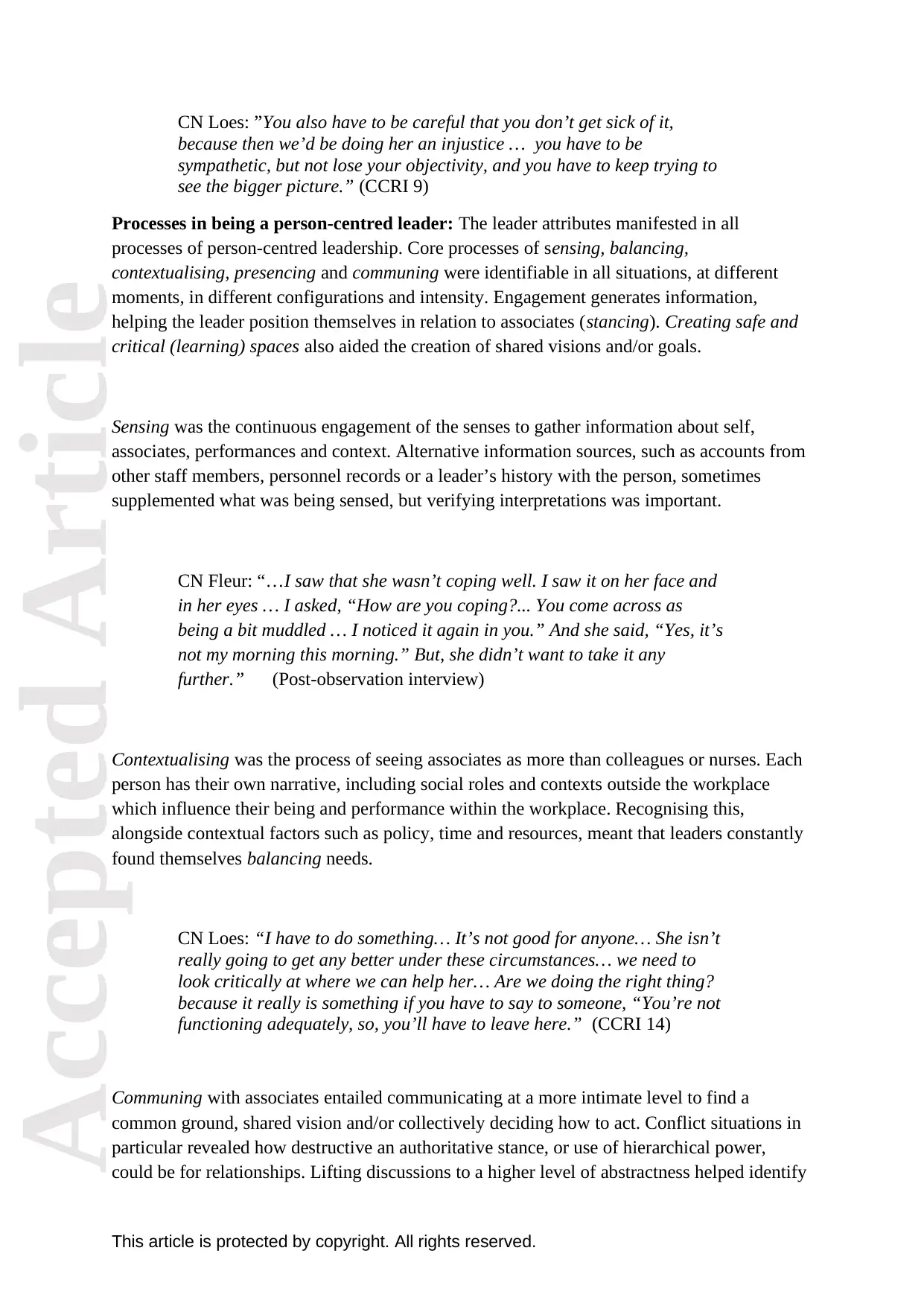
Accepted Article
This article is protected by copyright. All rights reserved.
CN Loes: ”You also have to be careful that you don’t get sick of it,
because then we’d be doing her an injustice … you have to be
sympathetic, but not lose your objectivity, and you have to keep trying to
see the bigger picture.” (CCRI 9)
Processes in being a person-centred leader: The leader attributes manifested in all
processes of person-centred leadership. Core processes of sensing, balancing,
contextualising, presencing and communing were identifiable in all situations, at different
moments, in different configurations and intensity. Engagement generates information,
helping the leader position themselves in relation to associates (stancing). Creating safe and
critical (learning) spaces also aided the creation of shared visions and/or goals.
Sensing was the continuous engagement of the senses to gather information about self,
associates, performances and context. Alternative information sources, such as accounts from
other staff members, personnel records or a leader’s history with the person, sometimes
supplemented what was being sensed, but verifying interpretations was important.
CN Fleur: “…I saw that she wasn’t coping well. I saw it on her face and
in her eyes … I asked, “How are you coping?... You come across as
being a bit muddled … I noticed it again in you.” And she said, “Yes, it’s
not my morning this morning.” But, she didn’t want to take it any
further.” (Post-observation interview)
Contextualising was the process of seeing associates as more than colleagues or nurses. Each
person has their own narrative, including social roles and contexts outside the workplace
which influence their being and performance within the workplace. Recognising this,
alongside contextual factors such as policy, time and resources, meant that leaders constantly
found themselves balancing needs.
CN Loes: “I have to do something… It’s not good for anyone… She isn’t
really going to get any better under these circumstances… we need to
look critically at where we can help her… Are we doing the right thing?
because it really is something if you have to say to someone, “You’re not
functioning adequately, so, you’ll have to leave here.” (CCRI 14)
Communing with associates entailed communicating at a more intimate level to find a
common ground, shared vision and/or collectively deciding how to act. Conflict situations in
particular revealed how destructive an authoritative stance, or use of hierarchical power,
could be for relationships. Lifting discussions to a higher level of abstractness helped identify
This article is protected by copyright. All rights reserved.
CN Loes: ”You also have to be careful that you don’t get sick of it,
because then we’d be doing her an injustice … you have to be
sympathetic, but not lose your objectivity, and you have to keep trying to
see the bigger picture.” (CCRI 9)
Processes in being a person-centred leader: The leader attributes manifested in all
processes of person-centred leadership. Core processes of sensing, balancing,
contextualising, presencing and communing were identifiable in all situations, at different
moments, in different configurations and intensity. Engagement generates information,
helping the leader position themselves in relation to associates (stancing). Creating safe and
critical (learning) spaces also aided the creation of shared visions and/or goals.
Sensing was the continuous engagement of the senses to gather information about self,
associates, performances and context. Alternative information sources, such as accounts from
other staff members, personnel records or a leader’s history with the person, sometimes
supplemented what was being sensed, but verifying interpretations was important.
CN Fleur: “…I saw that she wasn’t coping well. I saw it on her face and
in her eyes … I asked, “How are you coping?... You come across as
being a bit muddled … I noticed it again in you.” And she said, “Yes, it’s
not my morning this morning.” But, she didn’t want to take it any
further.” (Post-observation interview)
Contextualising was the process of seeing associates as more than colleagues or nurses. Each
person has their own narrative, including social roles and contexts outside the workplace
which influence their being and performance within the workplace. Recognising this,
alongside contextual factors such as policy, time and resources, meant that leaders constantly
found themselves balancing needs.
CN Loes: “I have to do something… It’s not good for anyone… She isn’t
really going to get any better under these circumstances… we need to
look critically at where we can help her… Are we doing the right thing?
because it really is something if you have to say to someone, “You’re not
functioning adequately, so, you’ll have to leave here.” (CCRI 14)
Communing with associates entailed communicating at a more intimate level to find a
common ground, shared vision and/or collectively deciding how to act. Conflict situations in
particular revealed how destructive an authoritative stance, or use of hierarchical power,
could be for relationships. Lifting discussions to a higher level of abstractness helped identify
⊘ This is a preview!⊘
Do you want full access?
Subscribe today to unlock all pages.

Trusted by 1+ million students worldwide
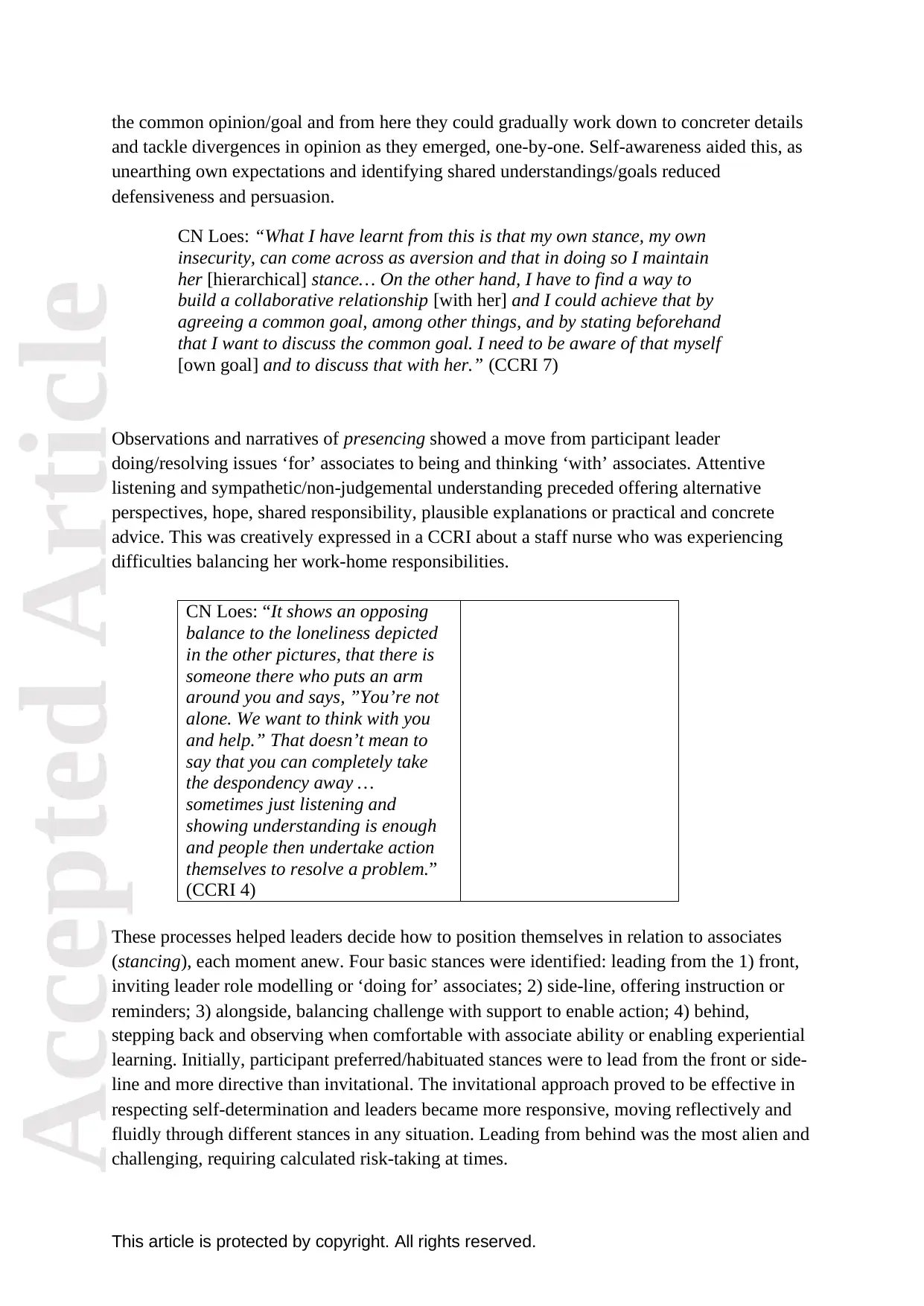
Accepted Article
This article is protected by copyright. All rights reserved.
the common opinion/goal and from here they could gradually work down to concreter details
and tackle divergences in opinion as they emerged, one-by-one. Self-awareness aided this, as
unearthing own expectations and identifying shared understandings/goals reduced
defensiveness and persuasion.
CN Loes: “What I have learnt from this is that my own stance, my own
insecurity, can come across as aversion and that in doing so I maintain
her [hierarchical] stance… On the other hand, I have to find a way to
build a collaborative relationship [with her] and I could achieve that by
agreeing a common goal, among other things, and by stating beforehand
that I want to discuss the common goal. I need to be aware of that myself
[own goal] and to discuss that with her.” (CCRI 7)
Observations and narratives of presencing showed a move from participant leader
doing/resolving issues ‘for’ associates to being and thinking ‘with’ associates. Attentive
listening and sympathetic/non-judgemental understanding preceded offering alternative
perspectives, hope, shared responsibility, plausible explanations or practical and concrete
advice. This was creatively expressed in a CCRI about a staff nurse who was experiencing
difficulties balancing her work-home responsibilities.
CN Loes: “It shows an opposing
balance to the loneliness depicted
in the other pictures, that there is
someone there who puts an arm
around you and says, ”You’re not
alone. We want to think with you
and help.” That doesn’t mean to
say that you can completely take
the despondency away …
sometimes just listening and
showing understanding is enough
and people then undertake action
themselves to resolve a problem.”
(CCRI 4)
These processes helped leaders decide how to position themselves in relation to associates
(stancing), each moment anew. Four basic stances were identified: leading from the 1) front,
inviting leader role modelling or ‘doing for’ associates; 2) side-line, offering instruction or
reminders; 3) alongside, balancing challenge with support to enable action; 4) behind,
stepping back and observing when comfortable with associate ability or enabling experiential
learning. Initially, participant preferred/habituated stances were to lead from the front or side-
line and more directive than invitational. The invitational approach proved to be effective in
respecting self-determination and leaders became more responsive, moving reflectively and
fluidly through different stances in any situation. Leading from behind was the most alien and
challenging, requiring calculated risk-taking at times.
This article is protected by copyright. All rights reserved.
the common opinion/goal and from here they could gradually work down to concreter details
and tackle divergences in opinion as they emerged, one-by-one. Self-awareness aided this, as
unearthing own expectations and identifying shared understandings/goals reduced
defensiveness and persuasion.
CN Loes: “What I have learnt from this is that my own stance, my own
insecurity, can come across as aversion and that in doing so I maintain
her [hierarchical] stance… On the other hand, I have to find a way to
build a collaborative relationship [with her] and I could achieve that by
agreeing a common goal, among other things, and by stating beforehand
that I want to discuss the common goal. I need to be aware of that myself
[own goal] and to discuss that with her.” (CCRI 7)
Observations and narratives of presencing showed a move from participant leader
doing/resolving issues ‘for’ associates to being and thinking ‘with’ associates. Attentive
listening and sympathetic/non-judgemental understanding preceded offering alternative
perspectives, hope, shared responsibility, plausible explanations or practical and concrete
advice. This was creatively expressed in a CCRI about a staff nurse who was experiencing
difficulties balancing her work-home responsibilities.
CN Loes: “It shows an opposing
balance to the loneliness depicted
in the other pictures, that there is
someone there who puts an arm
around you and says, ”You’re not
alone. We want to think with you
and help.” That doesn’t mean to
say that you can completely take
the despondency away …
sometimes just listening and
showing understanding is enough
and people then undertake action
themselves to resolve a problem.”
(CCRI 4)
These processes helped leaders decide how to position themselves in relation to associates
(stancing), each moment anew. Four basic stances were identified: leading from the 1) front,
inviting leader role modelling or ‘doing for’ associates; 2) side-line, offering instruction or
reminders; 3) alongside, balancing challenge with support to enable action; 4) behind,
stepping back and observing when comfortable with associate ability or enabling experiential
learning. Initially, participant preferred/habituated stances were to lead from the front or side-
line and more directive than invitational. The invitational approach proved to be effective in
respecting self-determination and leaders became more responsive, moving reflectively and
fluidly through different stances in any situation. Leading from behind was the most alien and
challenging, requiring calculated risk-taking at times.
Paraphrase This Document
Need a fresh take? Get an instant paraphrase of this document with our AI Paraphraser
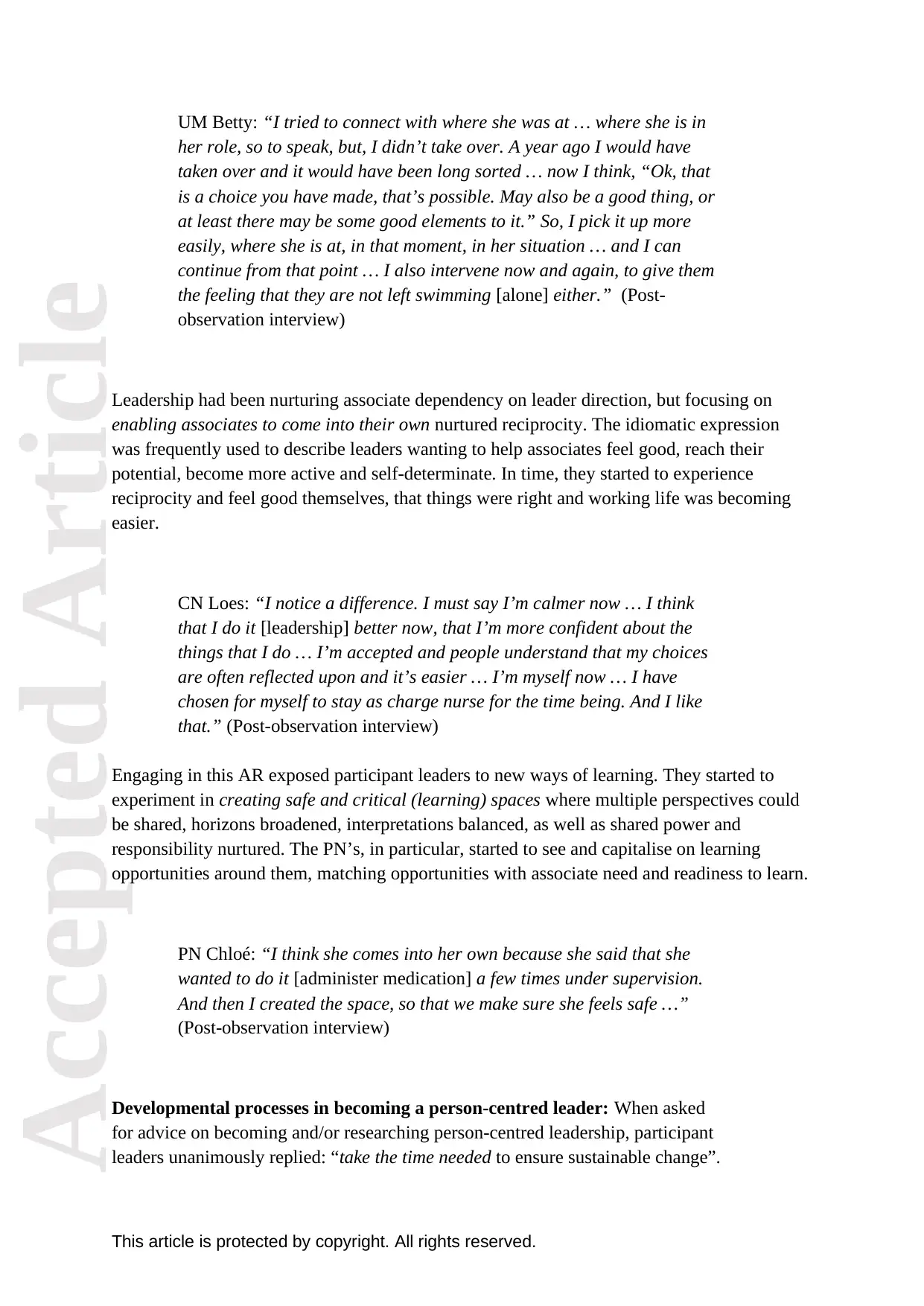
Accepted Article
This article is protected by copyright. All rights reserved.
UM Betty: “I tried to connect with where she was at … where she is in
her role, so to speak, but, I didn’t take over. A year ago I would have
taken over and it would have been long sorted … now I think, “Ok, that
is a choice you have made, that’s possible. May also be a good thing, or
at least there may be some good elements to it.” So, I pick it up more
easily, where she is at, in that moment, in her situation … and I can
continue from that point … I also intervene now and again, to give them
the feeling that they are not left swimming [alone] either.” (Post-
observation interview)
Leadership had been nurturing associate dependency on leader direction, but focusing on
enabling associates to come into their own nurtured reciprocity. The idiomatic expression
was frequently used to describe leaders wanting to help associates feel good, reach their
potential, become more active and self-determinate. In time, they started to experience
reciprocity and feel good themselves, that things were right and working life was becoming
easier.
CN Loes: “I notice a difference. I must say I’m calmer now … I think
that I do it [leadership] better now, that I’m more confident about the
things that I do … I’m accepted and people understand that my choices
are often reflected upon and it’s easier … I’m myself now … I have
chosen for myself to stay as charge nurse for the time being. And I like
that.” (Post-observation interview)
Engaging in this AR exposed participant leaders to new ways of learning. They started to
experiment in creating safe and critical (learning) spaces where multiple perspectives could
be shared, horizons broadened, interpretations balanced, as well as shared power and
responsibility nurtured. The PN’s, in particular, started to see and capitalise on learning
opportunities around them, matching opportunities with associate need and readiness to learn.
PN Chloé: “I think she comes into her own because she said that she
wanted to do it [administer medication] a few times under supervision.
And then I created the space, so that we make sure she feels safe …”
(Post-observation interview)
Developmental processes in becoming a person-centred leader: When asked
for advice on becoming and/or researching person-centred leadership, participant
leaders unanimously replied: “take the time needed to ensure sustainable change”.
This article is protected by copyright. All rights reserved.
UM Betty: “I tried to connect with where she was at … where she is in
her role, so to speak, but, I didn’t take over. A year ago I would have
taken over and it would have been long sorted … now I think, “Ok, that
is a choice you have made, that’s possible. May also be a good thing, or
at least there may be some good elements to it.” So, I pick it up more
easily, where she is at, in that moment, in her situation … and I can
continue from that point … I also intervene now and again, to give them
the feeling that they are not left swimming [alone] either.” (Post-
observation interview)
Leadership had been nurturing associate dependency on leader direction, but focusing on
enabling associates to come into their own nurtured reciprocity. The idiomatic expression
was frequently used to describe leaders wanting to help associates feel good, reach their
potential, become more active and self-determinate. In time, they started to experience
reciprocity and feel good themselves, that things were right and working life was becoming
easier.
CN Loes: “I notice a difference. I must say I’m calmer now … I think
that I do it [leadership] better now, that I’m more confident about the
things that I do … I’m accepted and people understand that my choices
are often reflected upon and it’s easier … I’m myself now … I have
chosen for myself to stay as charge nurse for the time being. And I like
that.” (Post-observation interview)
Engaging in this AR exposed participant leaders to new ways of learning. They started to
experiment in creating safe and critical (learning) spaces where multiple perspectives could
be shared, horizons broadened, interpretations balanced, as well as shared power and
responsibility nurtured. The PN’s, in particular, started to see and capitalise on learning
opportunities around them, matching opportunities with associate need and readiness to learn.
PN Chloé: “I think she comes into her own because she said that she
wanted to do it [administer medication] a few times under supervision.
And then I created the space, so that we make sure she feels safe …”
(Post-observation interview)
Developmental processes in becoming a person-centred leader: When asked
for advice on becoming and/or researching person-centred leadership, participant
leaders unanimously replied: “take the time needed to ensure sustainable change”.
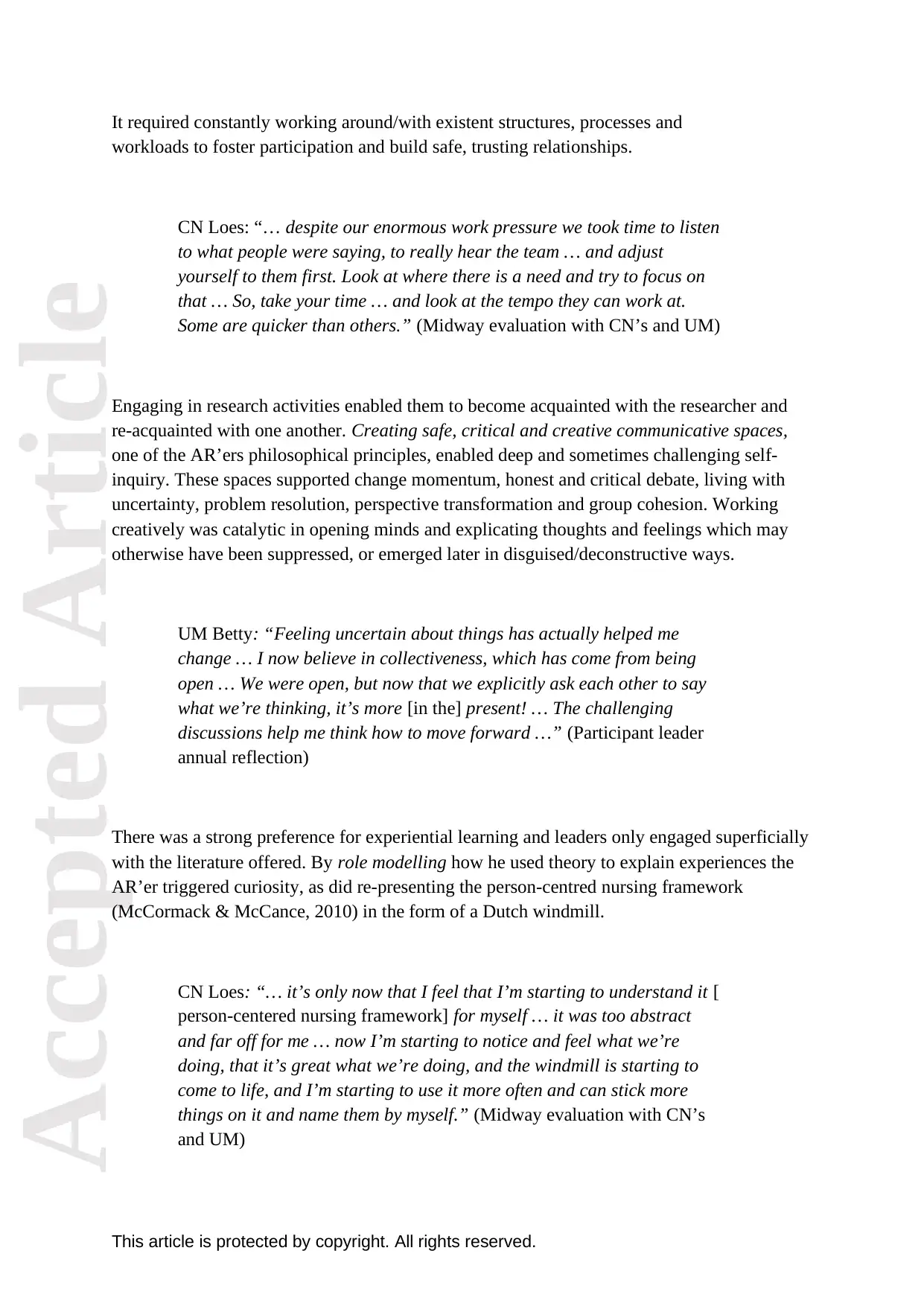
Accepted Article
This article is protected by copyright. All rights reserved.
It required constantly working around/with existent structures, processes and
workloads to foster participation and build safe, trusting relationships.
CN Loes: “… despite our enormous work pressure we took time to listen
to what people were saying, to really hear the team … and adjust
yourself to them first. Look at where there is a need and try to focus on
that … So, take your time … and look at the tempo they can work at.
Some are quicker than others.” (Midway evaluation with CN’s and UM)
Engaging in research activities enabled them to become acquainted with the researcher and
re-acquainted with one another. Creating safe, critical and creative communicative spaces,
one of the AR’ers philosophical principles, enabled deep and sometimes challenging self-
inquiry. These spaces supported change momentum, honest and critical debate, living with
uncertainty, problem resolution, perspective transformation and group cohesion. Working
creatively was catalytic in opening minds and explicating thoughts and feelings which may
otherwise have been suppressed, or emerged later in disguised/deconstructive ways.
UM Betty: “Feeling uncertain about things has actually helped me
change … I now believe in collectiveness, which has come from being
open … We were open, but now that we explicitly ask each other to say
what we’re thinking, it’s more [in the] present! … The challenging
discussions help me think how to move forward …” (Participant leader
annual reflection)
There was a strong preference for experiential learning and leaders only engaged superficially
with the literature offered. By role modelling how he used theory to explain experiences the
AR’er triggered curiosity, as did re-presenting the person-centred nursing framework
(McCormack & McCance, 2010) in the form of a Dutch windmill.
CN Loes: “… it’s only now that I feel that I’m starting to understand it [
person-centered nursing framework] for myself … it was too abstract
and far off for me … now I’m starting to notice and feel what we’re
doing, that it’s great what we’re doing, and the windmill is starting to
come to life, and I’m starting to use it more often and can stick more
things on it and name them by myself.” (Midway evaluation with CN’s
and UM)
This article is protected by copyright. All rights reserved.
It required constantly working around/with existent structures, processes and
workloads to foster participation and build safe, trusting relationships.
CN Loes: “… despite our enormous work pressure we took time to listen
to what people were saying, to really hear the team … and adjust
yourself to them first. Look at where there is a need and try to focus on
that … So, take your time … and look at the tempo they can work at.
Some are quicker than others.” (Midway evaluation with CN’s and UM)
Engaging in research activities enabled them to become acquainted with the researcher and
re-acquainted with one another. Creating safe, critical and creative communicative spaces,
one of the AR’ers philosophical principles, enabled deep and sometimes challenging self-
inquiry. These spaces supported change momentum, honest and critical debate, living with
uncertainty, problem resolution, perspective transformation and group cohesion. Working
creatively was catalytic in opening minds and explicating thoughts and feelings which may
otherwise have been suppressed, or emerged later in disguised/deconstructive ways.
UM Betty: “Feeling uncertain about things has actually helped me
change … I now believe in collectiveness, which has come from being
open … We were open, but now that we explicitly ask each other to say
what we’re thinking, it’s more [in the] present! … The challenging
discussions help me think how to move forward …” (Participant leader
annual reflection)
There was a strong preference for experiential learning and leaders only engaged superficially
with the literature offered. By role modelling how he used theory to explain experiences the
AR’er triggered curiosity, as did re-presenting the person-centred nursing framework
(McCormack & McCance, 2010) in the form of a Dutch windmill.
CN Loes: “… it’s only now that I feel that I’m starting to understand it [
person-centered nursing framework] for myself … it was too abstract
and far off for me … now I’m starting to notice and feel what we’re
doing, that it’s great what we’re doing, and the windmill is starting to
come to life, and I’m starting to use it more often and can stick more
things on it and name them by myself.” (Midway evaluation with CN’s
and UM)
⊘ This is a preview!⊘
Do you want full access?
Subscribe today to unlock all pages.

Trusted by 1+ million students worldwide
1 out of 31
Related Documents
Your All-in-One AI-Powered Toolkit for Academic Success.
+13062052269
info@desklib.com
Available 24*7 on WhatsApp / Email
![[object Object]](/_next/static/media/star-bottom.7253800d.svg)
Unlock your academic potential
Copyright © 2020–2025 A2Z Services. All Rights Reserved. Developed and managed by ZUCOL.




